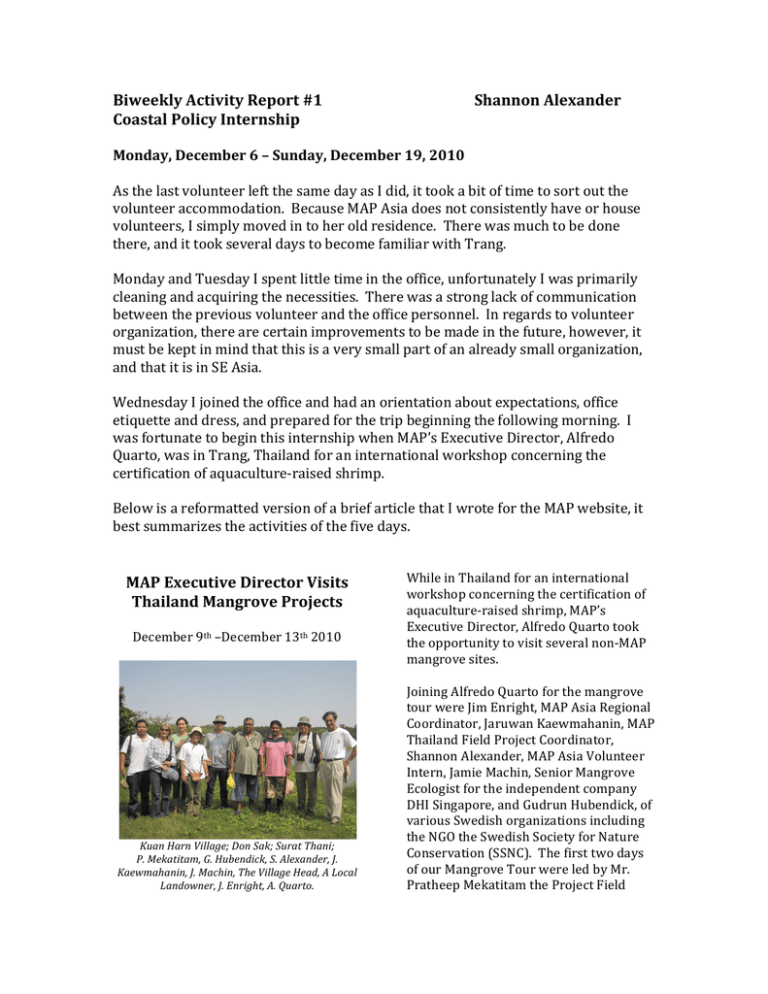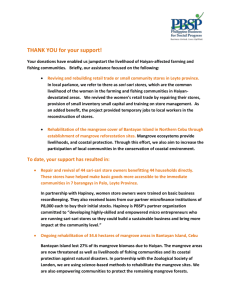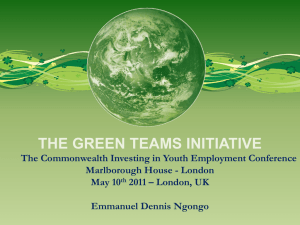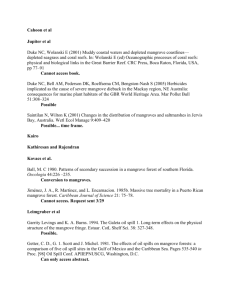Document 10775646
advertisement

Biweekly Activity Report #1 Coastal Policy Internship Shannon Alexander Monday, December 6 – Sunday, December 19, 2010 As the last volunteer left the same day as I did, it took a bit of time to sort out the volunteer accommodation. Because MAP Asia does not consistently have or house volunteers, I simply moved in to her old residence. There was much to be done there, and it took several days to become familiar with Trang. Monday and Tuesday I spent little time in the office, unfortunately I was primarily cleaning and acquiring the necessities. There was a strong lack of communication between the previous volunteer and the office personnel. In regards to volunteer organization, there are certain improvements to be made in the future, however, it must be kept in mind that this is a very small part of an already small organization, and that it is in SE Asia. Wednesday I joined the office and had an orientation about expectations, office etiquette and dress, and prepared for the trip beginning the following morning. I was fortunate to begin this internship when MAP’s Executive Director, Alfredo Quarto, was in Trang, Thailand for an international workshop concerning the certification of aquaculture-­‐raised shrimp. Below is a reformatted version of a brief article that I wrote for the MAP website, it best summarizes the activities of the five days. MAP Executive Director Visits Thailand Mangrove Projects December 9th –December 13th 2010 Kuan Harn Village; Don Sak; Surat Thani; P. Mekatitam, G. Hubendick, S. Alexander, J. Kaewmahanin, J. Machin, The Village Head, A Local Landowner, J. Enright, A. Quarto. While in Thailand for an international workshop concerning the certification of aquaculture-­‐raised shrimp, MAP’s Executive Director, Alfredo Quarto took the opportunity to visit several non-­‐MAP mangrove sites. Joining Alfredo Quarto for the mangrove tour were Jim Enright, MAP Asia Regional Coordinator, Jaruwan Kaewmahanin, MAP Thailand Field Project Coordinator, Shannon Alexander, MAP Asia Volunteer Intern, Jamie Machin, Senior Mangrove Ecologist for the independent company DHI Singapore, and Gudrun Hubendick, of various Swedish organizations including the NGO the Swedish Society for Nature Conservation (SSNC). The first two days of our Mangrove Tour were led by Mr. Pratheep Mekatitam the Project Field Coordinator for Wetlands International’s Thailand Office. The convergence of such a variety of individuals, all of different backgrounds, working for a variety of different kinds of organizations led to an exciting exchange of ideas and concepts. Within Surat Thani Province we visited several projects, most of which were collaborations between Mangroves for the Future (MFF), Wetlands International (WI), and Thailand’s Department of Marine and Coastal Resources (DMCR). We met with the village heads of both Kuan Harn Village and Ta Kien Thong Village and visited a site in Li Ledt Village. We visited various abandoned shrimp ponds that are to be improved to active mangrove areas. Some of the areas are intended to be productive silvo-­‐fisheries areas, others simply restored mangrove areas, but all are maintained by the local communities and contribute to their livelihoods directly. Some communities protected the mangrove area in order to repay interest to small business loans (given for the purchase of such necessities as fish-­‐smoking equipment), to use for traditional, less intrusive fishing methods (primarily for mud crab), or even to improve the water quality for their active shrimp ponds and increase the local fish stock. The sizes of the different project areas varied from 50 rai to approximately 800 rai (8 hectare or 20 acres to 128 hectare or 316 acres). Local landowner and farmer at an MFF, WI Abandoned Shrimp Pond to Silvo-­Fisheries Site in Kuan Harn Village Although Khao Sam Roi Yot National Park in the Kuiburi and Pranburi Districts of the Prachuap Khiri Khan Province, established in 1966 was Thailand’s first coastal National Park and 11th RAMSAR site and boasts a stunning variety of landscapes and diverse, it was disappointing in its work with mangroves. There was an obviously high level of encroachment by active shrimp farms and the inappropriate allocation of funds and time in converting natural salt flat areas into primarily unsuccessful mangrove plantations. Alfredo Quarto Pointing out Mismanaged Mangrove Planting Area at Khao Sam Roi Yot National Park In the same area, just on the outskirts of the city of Pran Buri, within the Khlong Kao-­‐Khlong Khoi National Forest Reserve we visited Sirinart Rajini Ecosystem Learning Center, funded by the Petroleum Authority of Thailand (PTT). Originally mangrove, this area was contracted for shrimp farming concessions for fifteen years, however in 1996, the concessions were revoked and the land incorporated into the Royal-­‐Initiated Pran Buri Estuary Reforestation Program. The learning center here is a free resource and park for Thai residents and visitors and has high quality interpretive signage, images, and displays within the learning center and along the well-­‐maintained mangrove walkway with an observation tower overlooking the entire area. Group at Sirinart Rajini Ecosystem Learning Center S. Alexander, G. Hubendick, J. Enright, Center Guide, A. Quarto, J. Kaewmahanin Enright, J. Machin and Family The Center also leads school groups and has interactive educational pamphlets (all in Thai) geared at different age groups. Interestingly, local fisherfolk are allowed to use about two thirds of the 85 rai (33.6 acres or 13.6 hectare) of restored area for fishing, primarily of mud crab. Although the area by most respects appears to be a huge success, both in visitor education, facility effectiveness, and successful increase in mangrove cover, it was still noted that the variety of mangrove species was extremely limited, probably due to limited natural influx of mangrove seeds and monocultural planting. The collaboration and contribution of the Royal family and the private enterprise PTT continues to be a very successful demonstration of what they call “a man-­‐ made forest” Our visit to the coastal fishing community of Li Ledt along Ban Don Bay, in Surat Thani was, I think, the highlight of this tour. Seeing first hand a protected area, that continues to expand, that has recovered to have an almost virgin forest appearance, seeing the local people working to protect their environment and their livelihoods, and in so doing, protecting one of the most valuable ecosystems on the planet. We were able to witness first hand various approaches to mangrove protection and restoration, and each of us will be able to compare and utilize what we have learned with our own network, and now with one another. An international collaboration between a diverse group of individuals with similar goals and aspirations for the future of our wetlands and mangrove forests is possible, and it is happening. Khao Sam Roi Yot National Park; J. Enright, A. Quarto, J. Kaewmahanin, G. Hubendick Written by Shannon Alexander; 22 December, 2010 …….. MFF, WI Site in along Ban Don Bay, MFF, WI Site along Ban Don Bay, I would like to add a bit more about December 11th in Khao Sam Roi Yot National Park. Approaching the park, after already having gone through the checkpoint and paid the 200 Bhat foreigner entrance fee (I believe the local fee is only 30 Bhat), the road was lined with a mix of abandoned and active shrimp ponds. The boundary of the park is extremely ambiguous, allowing the shrimp ponds to continue to operate and expand. There happened to be a harvest in progress, and so a large truck was occupying half of the road at one point, with a long tent set up to protect the fast-­‐ moving sorters and the soon-­‐to-­‐be-­‐sold crustaceans from the intense sun. There are several methods of selling the shrimp. Three potential buyers submit a confidential bid for the price per kg of shrimp that they are willing to pay, and the shrimp farmer accepts one – assumedly the highest. Alternatively, the shrimp farmers have an established arrangement with a large company (there are two large ones in Thailand), or they may use the hired temporary group of workers to size-­‐ sort the shrimp and sell it by the kg either to local buyers or one of the two large companies. At the park headquarters, I was initially excited to see a park ranger in front of a large group of young Thai (later I found out that they were students from a University in BKK) holding a large mangrove propagule, speaking and gesturing enthusiastically. Those students were to plant some mangrove that very day – how great! Until you see the areas that represent what the park considers “successful mangrove” cover area. Straight ditches dug through the mudflats and saltflats, with canals to increase the standing water in an area completely ill suited to mangrove survival. In an attempt to make the headquarters area more ‘attractive and green’, increase mangrove cover (albeit in an area that is not meant to have mangroves), attract publicity, and to insure a large budget for years to come, huge plots of land that were once important, and entirely different ecosystems, are being converted to systems of raised areas and ditches, into which are mono-­‐culturally planted Rhizophora mangrove seedlings. None of which seem to be surviving all too well. In 1992, when Jim Enright worked for the park, they were already planting in some areas… some of the same areas that they are annually planting more intensively today. Although previous attempts to force mangroves into an environment that has never naturally been inhabited by these trees have been unsuccessful, there is continued and increased efforts in this direction. The Thailand government has argued recently that there is actually an annual increase in mangrove cover/ percentage, however, if this is the sort of cover from which they are accruing these new numbers, then I fail to see any actual increase in mangrove ecosystems, rather a destruction of mudflats and saltflats, and an increase in area that is not serving as an ideal habitat for mangrove or saltflat species, nor serving the same imperative carbon cycling, cleansing, nursery functions that any of these ecosystems do naturally. After visiting so many rural, coastal areas and parks, it is quite shocking to step foot into the hustle and bustle, and pavement and people of Bangkok. But here, in the cities are many people who can and do make a difference, who buy shrimp, who research online, who visit parks, who make and donate hard-­‐earned wages. On Tuesday the 14th, we made the twelve-­‐hour trip back from Bangkok to Trang. The next three days I worked in the office, familiarizing myself with MAP’s google docs and the dropbox account, organized the volunteer email account, and updated the master donor chart and current proposal chart (as the last year of relevant information was in list form instead of incorporated into their respective spreadsheets). I also created the MAP Holiday/New Years electronic greeting card, altered the environmental awards spreadsheet, and met with Jim to discuss specific goals and project for my internship. Saturday and Sunday I took much needed time off. Although I thoroughly enjoyed being able to join the mangrove tour, there were a lot of bumps in the transition. There was some tension between the past volunteer and the MAP office, which made my first week uncomfortable. In my brief meeting with the previous volunteer, she continuously commented certain attributes of staff members and the volunteer situation in general. I was also cc’d on the correspondence between two of them, putting me into a social situation that I had nothing to do with. This was a stressful time, but educational. There will, more often than not, be personal problems that arise in any work environment, regardless of the organization’s wonderful overall mission. Open communication is imperative to the success of not only any relationship, but any project.






